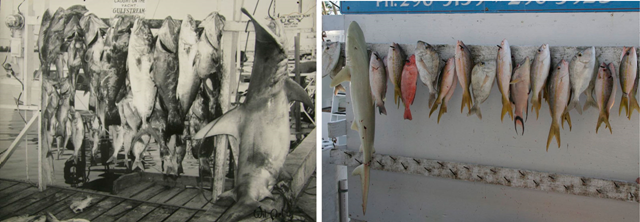Image of the Day: Landed trophy fish in Florida, 1957 and 2007
These images were taken from the same display board, from the same dock, from the same recreational fishery in Key West, Florida. The board displays the largest trophy fish that were caught that day. You can clearly see that with time, the “largest” caught fish get significantly smaller and smaller. A study by McClenachan that analyzed photos like these found that in the 50 year period studied, the average length of trophy fish declined from 91.7 to 42.4 cm, and the average weight declined from 19.9 to 2.3 kg. In addition to the obvious change in size, there was also a major shift in species composition, and the average length of sharks declined by over 50%. These images demonstrate that the fishing pressure we are putting on our environment throughout time causes drastic shifts in the ocean environment, particularly in regard to fish size. Image: Loren McClenachan
Source: McClenachan, Loren. 2009. Documenting Loss of Large Trophy Fish from the Florida Keys with Historical Photographs. Conservation Biology 23, 3:636-643
